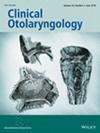Quality of Life and Sleep Outcomes in Obstructive Sleep Apnoea Following Transoral Robotic Surgery: A Meta-Analysis
Abstract
Objective
Obstructive sleep apnoea (OSA) can have a significant health burden in terms of sleep outcomes, systemic morbidity including cardiovascular and urological complications, and quality of life (QoL). Transoral robotic surgery (TORS) constitutes a novel option for patients where continuous positive airway pressure (CPAP) is not tolerated. This study aimed to assess OSA patients managed with TORS in terms of QoL and sleep outcomes.
Data Sources
Systematic review using EMBASE, CINAHL, MEDLINE, and Cochrane electronic databases.
Review Methods
Studies were identified assessing QoL (with validated QoL tools) and sleep outcomes in OSA patients managed with TORS. For the meta-analysis, mean difference (MD) was calculated using an inverse variance random-effects model.
Results
Four studies (252 patients) were included. Meta-analysis showed improvements in apnoea-hypopnea index (AHI) (MD = 20.01, p < 0.00001), Epworth Sleepiness Scale (ESS) (MD = 5.16, p < 0.00001) and lowest oxygen saturations (LSaO2) (MD = -7.05, p < 0.00001) following TORS. For QoL, there were improvements in voice, prostate and overactive bladder symptoms, erectile function, and overall QoL following TORS. Swallowing returned to baseline at 3 months. No major complications were reported, with all adverse events managed conservatively.
Conclusion
This systematic review and meta-analysis is the first in the existing literature to evaluate TORS as a treatment option for OSA across both sleep and QoL domains. Significant improvements were observed in both parameters following TORS. Whilst further research is needed, the current findings can assist clinicians and patients when it comes to clinical decision-making regarding personalised treatment options for a condition that carries a significant morbidity and QoL burden.
Trial Registration: PROSPERO: CRD42024448926

 求助内容:
求助内容: 应助结果提醒方式:
应助结果提醒方式:


